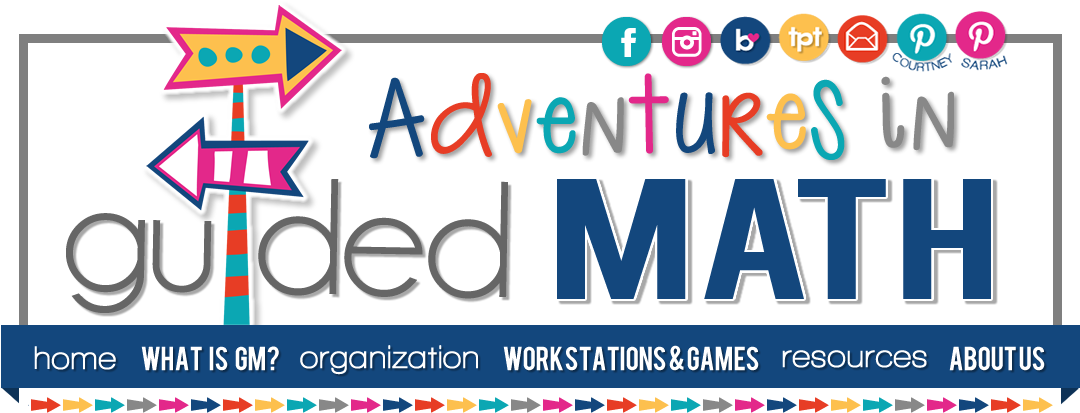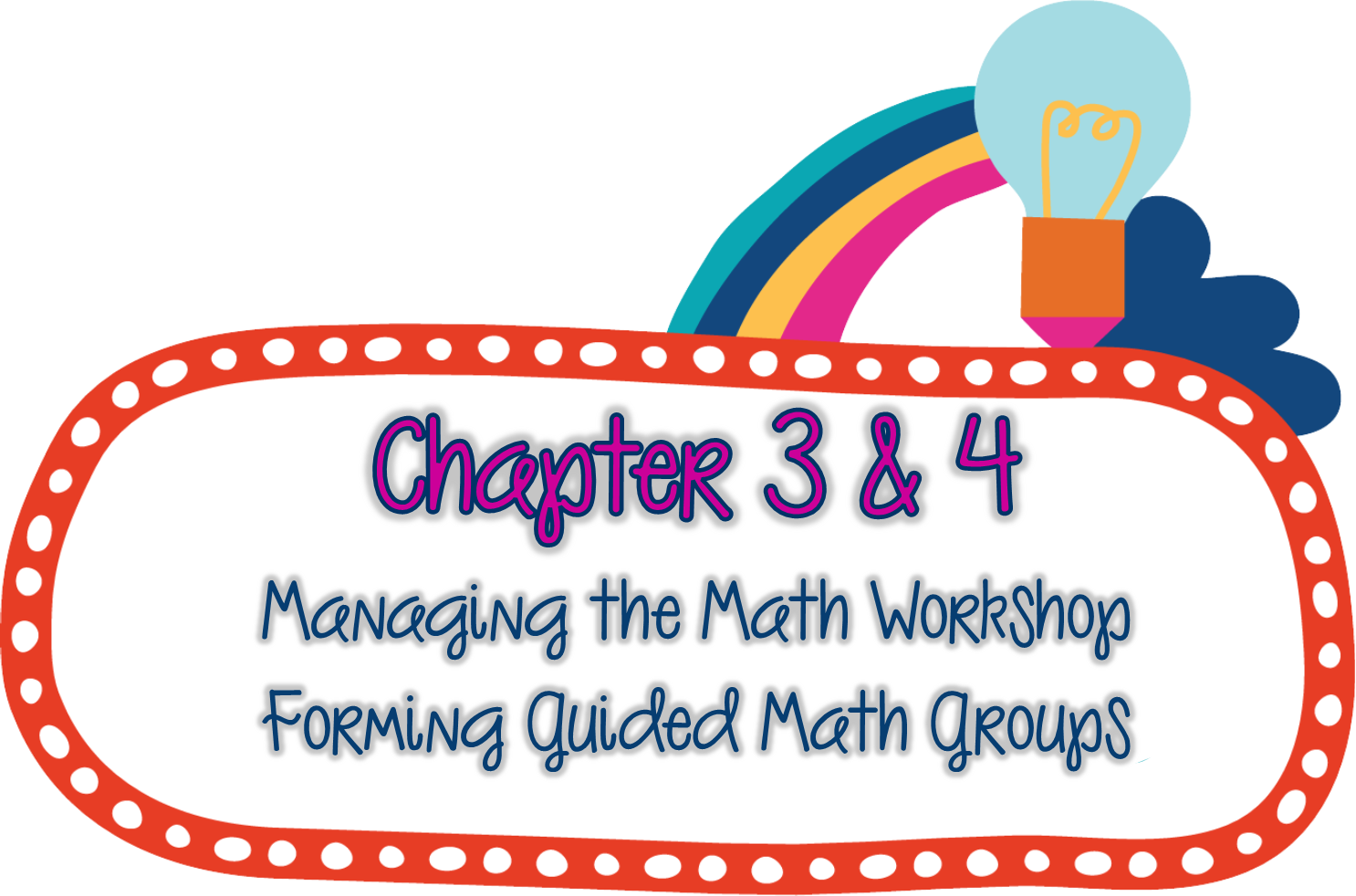Chapter Three
This chapter is all about preparing your kids for math workshop/guided math from the very first day of school. It's important to get off to a good start. Dr. Nicki recommends teachers do the following:
Establish Rules, Consequences, and Rewards
- Rules should be clear, explicit, few, written in positive language, and agreed upon by the class.
- Consequences should be immediate, fair/consistent. This leads to on task behavior.
- Rewards should be given (whether intrinsic and/or extrinsic) and kept--never taken away after they have been earned.
Establish Routines
- Students must know exactly what to do during work time.
- Spend the first four weeks practicing math workshop/guided math routines.
- Be consistent and predictable.
- Set timers and stick with your schedule.
- Have students practice working with centers independently, with partners, and in small groups.
- Practice a variety of centers.
- Teach students how to read task cards and transition.
- Practice classroom manners and good sportsmanship.
Use Math Anchor Charts
- What do mathematicians do?
- How can we prove our thinking?
- How do we talk about math?
- What is sharing?
Create Visual Schedules
- There are many options.
- Consider using student pictures and icons.
Dr. Nicki goes on to discuss establishing a guided math area and compiling your teacher toolkit.
Guided Math Area
- Have a home base, yet meet in other places as well, such as at a center or an interactive whiteboard.
- Teach students how to come to area prepared, gain teacher access, and leave the area.
- Everything that is needed should be located in this area.
- Observe, inquire, and take notes.
- Do a variety of activities.
Teacher Toolkit
- student work samples
- record-keeping charts/forms
- paper and pencils
- whiteboards, markers, and erasers
- manipulatives (specific to concepts/skills taught)
- dice, dominoes, cards, etc.
- number lines
- timers
- pointers
- clear plastic page protectors/folders (for graphic organizers, work mats, etc.)
Question 1:
Click here to read about what is in my teacher toolkit!
All of the centrally located math tools serve as my students' toolkits. Students can access any needed tools while working with centers/workstations, math journals, math vocabulary, math texts, etc. Tools may be used at any time to reason through problems, prove thinking, illustrate problems they create, etc. Students need not ask for permission to use a tool. At the beginning of the year, we gather to talk about the purpose of math tools, how to use tools correctly, and how to tidy up tools for the next person. Last year, our writing center was between our math drawers/tubs and cabinet with additional math tools. This year, the writing center will be relocated so that everything will be housed side-by-side.
All tools are organized and clearly labeled in tubs above workstation drawers and in our math tools cabinet (sorry, some reading stuff is shown here as well).
Question 3:
I do many of the things Dr. Nicki recommends in this chapter, yet I want to incorporate the use of different timers (I need them, and so do the kids!), picture icons on my schedule, and a new record keeping system (discussed below).
You can view and read about our schedule (circle diagram) by clicking here.
One of the most important things we do the very first day of school is establish classroom responsibilities (these are our rules). These are generated by students and agreed upon by all. They are signed and a copy is sent home to parents to discuss with their child. Then responsibilities are posted in the classroom all year. Students also keep a "My Responsibilities Sheet" in their take-home binders all week, and they rate themselves daily.
We also spend valuable time talking about my role as a teacher and their roles as students during guided math time. An anchor chart is created similar to Daily 5 t-chart--"I am..."/"Mrs. Masters is..." Courtney and I both do this and take small steps in those first weeks to ensure that students have built needed stamina. I am off limits when meeting with a group--BUT students know what to do when I am not available (as outlined on the t-chart). As we all know, sometimes students just think they need help, so the first question to ask is always, Do I truly need help? OR Can I think about what I need and problem solve on my own? OR Can I quickly and quietly ask another student in my area for assistance? :0)
One the most effective things I feel I do from the very first day is expect students to take an active roll in the classroom. If they can do it, I don't do it for them. If they can reason through a question, I expect them to answer it. I, of course, let my students know exactly what is expected and routines are practiced over and over. I always express my confidence in their abilities and try to instill in each a sense of pride.
Chapter 4:
Here are some highlights I pulled from chapter four:
- All students need the teacher's attention, no matter their skill level. Be sure to connect with every student each week.
- Teachers must collect a variety of data for each child (using pre-assessments) to inform grouping and guided math lessons.
- Group students into four groups: novice (no basic understanding of concept), apprentice (basic understanding), practitioners (at grade level), and experts (above level and need extension).
- Use ongoing observation and assessments to evaluate progress.
- Flexible grouping means students are grouped according to their ability/skill level related to a particular concept. Groups are fluid, allowing for movement in and out of each level depending on the concept/skill.
Several weekly guided math schedules are shared (p. 44-45).
Dr. Nicki ends by emphasizing the importance of keeping records--you need some way of keeping track of what you have done with students and your students' levels. However you choose to keep records should fit your style. Some great ways to record student work, take notes, and plan are shared (p. 46-47)
Question 1:
I meet with small groups daily! Some days I meet with two guided math groups, some days three or four.
Question 2:
Groups are very fluid--ever-changing based on constant reflection and ongoing assessments. More about assessments when we discuss chapter 5.
Question 3:
I have to be honest and say that I need to improve in this area. I struggle with finding a tool that is effective, yet efficient. I keep so much "in my head"---I truly know my students, BUT I know I can do better. I have tried many systems and have yet to find one that works for me (and I have been teaching this way for many years). I am going to try using clipboard sticky notes notes this year.
How I Will Use:
- I will be placing sticky notes on a clipboard as I record bits of information. One sticky note will be used per student observed or conferred with on a given day.
- My challenge was how to easily organize/store sticky notes, so I created some simple sticky note storage sheets for collecting notes over time. After making notes for the day, I will stick notes (not during class time) into individual student folders on these storage pages. This will house records for easy reference.
- I plan to stick notes in four columns, using the front and back of a storage sheet, with the last few days of some months being placed in the fourth column.
- Sticky notes will first be placed at the bottom of the sheet and then upward/overlapping as time passes. This way I can easily flip through notes at any time.
The flipping back and forth in a folder or index file during valuable classroom time is quite frustrating to me. I have hopes that this new system will work for me. Feel free to download the sticky note storage sheets I created!
Now it's your turn to share your thoughts about chapters 2 and 3, comment, and/or ask questions. Please! :0)
If you are a blogger and are interested in joining this book study, you may hop in at any time. Just sent us an email at guidedmathadventures.com so we can get emails out to you.
If you haven't taken our poll, feel free. Just click View to see the results!
Courtney blows back into town soon, so she will be back here with you on Wednesday to discuss chapter 5!
Have a wonderful week!








Setting up the math workshop model needs to be done with care. If it is not done fully, the whole system would be inefficient and cause teacher and student frustration. I especially liked when she talked about teaching kids how to win and lose. That is an important skill.
ReplyDeleteI agree! So important to teach that sportsmanship--much more fun for EVERYONE! Thanks again for sharing your words of wisdom... :0)
DeleteSarah
I just saw your Sticky Note Storage Sheets and love them. I can see using this idea for other areas as well. Thanks for getting my wheels spinning about how I can use this idea next year!
ReplyDeleteI really like the circle diagram that you use for your rotation! Thanks for the great pictures of your space and sharing your sticky note storage sheets.
ReplyDeleteCrystal
Teaching Little Miracles